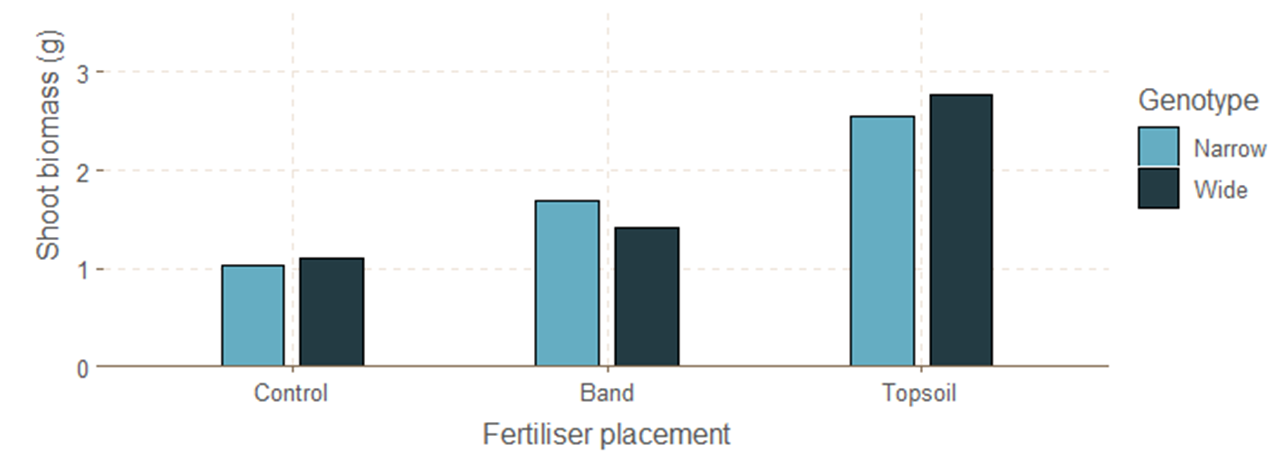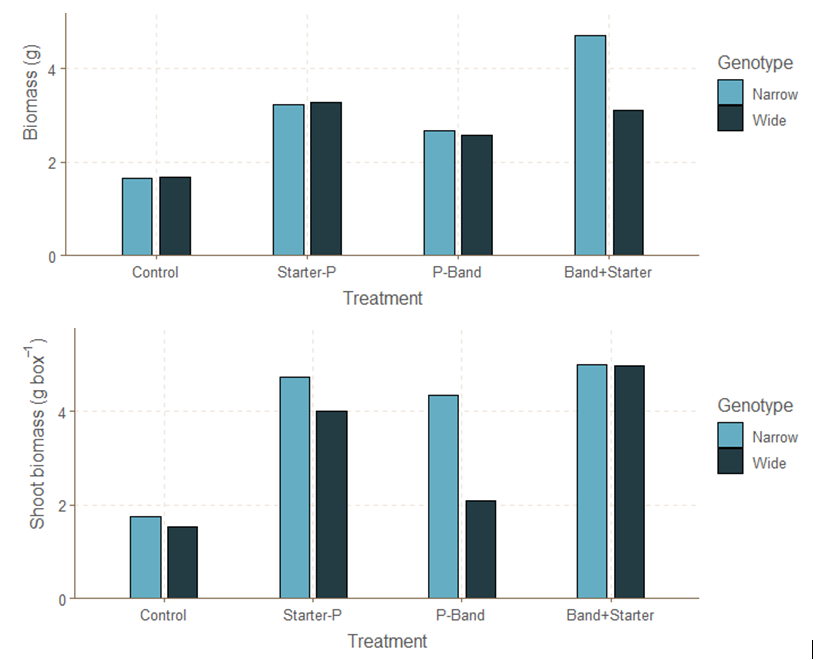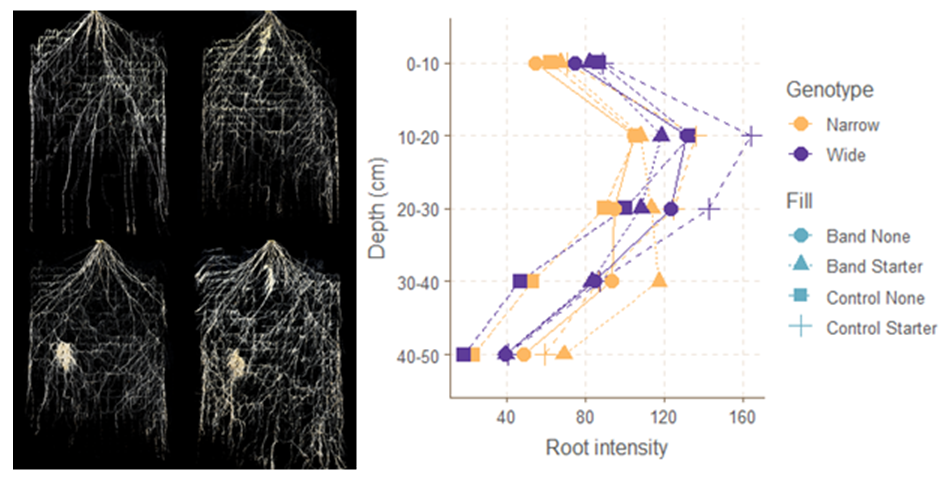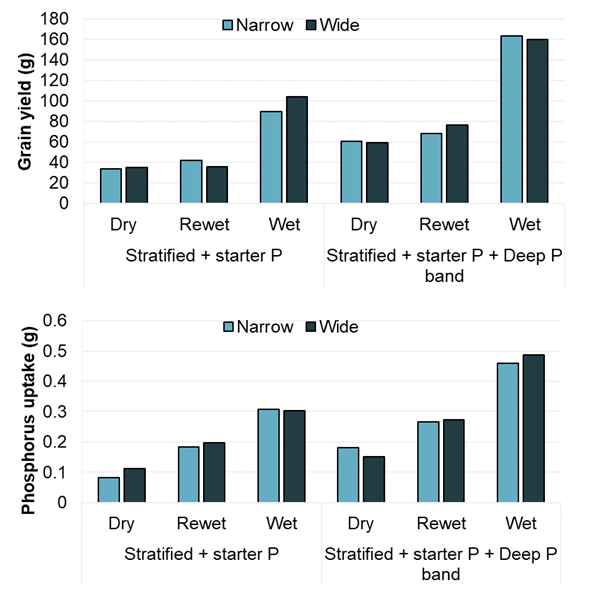Root research: What do wheat and sorghum roots do when water is in one part of the profile and phosphorus is in another? Root angle and why does it matter?
Author: Frederik van der Bom, Alwyn Williams, Nelly Raymond, Mike Bell (University of Queensland) | Date: 01 Mar 2022
Take home messages
- Over the past 3 years, we have conducted a series of controlled and semi-controlled experiments with wheat and sorghum genotypes with contrasting root angle, focussed on quantifying the productivity advantages of root architecture in soils with stratified and banded phosphorus (P) reserves
- Root angle was related to deeper exploration of the soil profile (narrow) and scavenging for P in the topsoil (wide), particularly early in the season. A narrow root system may access deep banded P slightly earlier than a wide root system, but it may also be at risk of ‘missing’ the bands completely, given the very small, enriched soil volumes. In contrast, a wide root angle could improve (early) exploration of the topsoil layer and crop growth if no P is available in deeper layers
- Access to surface-stratified P can quickly be reduced by the soil drying out, providing the crop with only a limited window of opportunity to take up P from this layer, and diminishing the potential benefits of shallow roots for improved P uptake. However, there may still be benefits of wide root angle genotypes through an ability to exploit rewetting events, but these would be highly dependent on in-season rainfall distribution
- Adequate crop nutrition is a critical success factor for root growth in general, and for root architecture to be reliably expressed. Severe P scarcity can eliminate the benefits of plant genetic selection, so the importance of placement and timing of P applications to optimise the performance of ‘designer’ root systems cannot be overlooked.
Introduction
This paper is based on results from a series of experiments supported by GRDC in the northern grains region, focussed on improving crop and agronomy/nutrition management. The specific aim of this research was to provide a better understanding of how genotypes with selected root angles will confer benefits in the growing conditions of the northern region.
A lot of investment is currently being made in breeding of genotypes with deeper root systems with the expectation that these will enhance exploitation of deep soil water reserves and enhance performance in environments with terminal drought. These genotypes are selected for specific root traits such as narrow root angle, which has been found to correlate to a deep root architecture in glasshouse studies. Selection for these traits generally occurs using rapid, high-throughput screening tools on juvenile plants (e.g. 5 day old seedlings, in the case of root angle). This approach offers advantages over evaluating rooting depth in the field, which is difficult, slow, and often gives variable results. However, evidence of relationships between root angle and rooting depth and field performance is limited. In part, this is likely because the conditions in the field are very different from those in which selection takes place. Therefore, it is important to understand how genotypes selected for contrasting traits like narrower root angle function in realistic production environments where moisture availability and distribution fluctuates during the season and less mobile nutrients are typically concentrated in the topsoil layers (stratified) or in narrow fertiliser bands. Both conditions have become increasingly common in the northern region.
Our aim was to quantify the impact of spatially separate distributions of water and immobile nutrients on the productivity of winter and summer cereals, with particular attention to how root traits (root angle) affect productivity in soils with stratified/banded nutrient reserves.
Water and phosphorus (P) distribution and implications for crop resource uptake
Before we discuss the role of crop genotypes and root architecture, it is worth noting how the soils in our cropping systems are managed, and what this means for crop resource availability and the crop root system. Historically, the productivity of grain systems in the northern region has been governed by the efficient capture, storage and extraction of water from the soil profile, with agronomic practices focused on
- Achieving a uniform and deep profile refill during a fallow to allow stored water to support crop growth during dry periods and
- Synchronising crop water use with key yield-determining growth stages.
However, many of the soils in the northern region are changing as a result of chronic under-fertilisation that has depleted native soil fertility, which has led to greater reliance on annual fertiliser inputs to meet crop nutrient demand.
Widespread adoption of conservation agricultural principles with minimal tillage have delivered important benefits, but also mean that P input from crop residues, manures or fertilisers tend to be applied onto the soil surface and/or in infrequent relatively wide bands with very little mixing through the soil layers. This has led to increased surface stratification of P (relatively high concentrations in the topsoil, but very much lower/depleted concentrations in deeper soil layers), which has a low mobility in these clay soils. As a result, P and water reserves can often become spatially separated in all but the wettest years, meaning root systems face major trade-offs for the exploration for P versus uptake of water. For example, genotypes with a narrow root angle may have deeper roots systems and the capacity to explore and take up water from deep subsoil layers, but may do so at the expense of topsoil exploration and uptake of stratified P, or be less efficient at finding and exploiting banded P fertiliser.
‘Deep banding’ (0.15-0.3 m depth) of P fertiliser is becoming an increasingly common management practice to provide more consistent crop access to P. This approach relies on the placement of P in layers that stay moist for longer, and on roots proliferating in and taking up P from the small, highly enriched soil volumes around the concentrated bands. Because the topsoil tends to dry rapidly, ‘deep bands’ can elicit significant crop responses, even in soils with relatively high topsoil P availability. The substantial responses to deep P bands across the northern region where subsoil P is low have been detailed in a number of recent publications (Lester et al. 2019, Sands et al. 2018).
How crop root systems respond to this heterogeneous distribution of P in the soil profile and its spatial separation with water will determine productivity in any given set of seasonal conditions. In other words, the exact benefit of root system architecture will depend on efficient capture of both resources that are in short supply.
Root angle and why does it matter?
Breeding for root architecture is thought to have a great potential for producing crops with ‘designer root systems’ better adapted to capturing soil resources such as water, or P. The big difference with traditional breeding is the focus on improving productivity by focusing on below-ground root traits and targeted development of varieties with phenotypes that include combinations of root traits that are presumed to be suited to specific environments. For example, selecting genotypes with a narrower angle should lead to a steeper root architecture enabling crops to access otherwise out-of-reach soil water, allowing prolonged growth and yield accumulation during grain filling, even under terminal drought conditions. In contrast, a wide root angle should lead to more shallow soil exploration, allowing a crop to more efficiently forage for resources from the top part of the soil profile. Although some evidence exists for these developments to work in environments with a single target constraint (i.e. either water or P limited), crops in the northern region are frequently exposed to multiple soil constraints simultaneously, with trade-offs such as described above (van der Bom et al., 2020).
Experimental approaches
During the past 3 years we have used lines defined by contrasting seminal or nodal root angles (i.e. wide vs narrow) from durum wheat and sorghum breeders to conduct a series of short-term (early-season), medium-term (anthesis) and full season experiments. These have been conducted in either rhizoboxes (short term) or in an automated lysimeter system with 60 cm × 30cm diameter soil cores (medium and long term) and have involved exposing these genotypes to different P distributions and soil water dynamics. Responses have been assessed on the basis of both aboveground and belowground growth. In assessing responses to P distribution, we used soils with low or high background P fertility and contrasted this to different zones and methods of fertiliser P placement (No P, starter P banded adjacent to the seed row, P mixed through the top 10 cm layer, and deep bands at 25cm. Rates of starter P (~6 kg P/ha) were much lower than those used to supply P for growth (~45 kg P/ha in the topsoil and banded P treatments). These P distributions were interacted with different soil water dynamics that would impact on root distributions and water/nutrient acquisition. These included constant watering to maintain the soil close to field capacity (‘wet’); allowing the topsoil to dry out (‘dry’); or allowing the soil to dry and then rewet (‘rewet’).
In all the experiments the soil was a P responsive grey vertosol from Hopeland (near Chinchilla), which received all other nutrients except P as a basal application in all experiments. The applications of P fertiliser were in the form of MAP.
For brevity, we primarily focus on the results from the experiments with durum wheat, but similar experiments have been conducted for sorghum lines. Generally, the sorghum data have provided a similar picture to that from durum wheat and suggest that same principles apply to both species.
Trial results
Early season growth responses to phosphorus placement
Durum wheat biomass showed clear positive growth responses to P placement, particularly to enriched topsoil P (Figure 1). The amounts of P supplied in the topsoil-P and the P-band treatments were equal, but for banded treatments roots had to grow through the very low background P layer first to reach the deep P band, whereas ample P would have been available close to the seed for the topsoil-P treatment. Secondly, the P band was applied as a concentrated row which would have reduced the probability of root to P fertiliser contact compared with the P that was distributed in the 10cm topsoil layer.
For both genotypes root intensity in the topsoil was largest when P was placed in this zone, and this fertilisation effect also improved root growth in deeper layers (Figure 2). In other words, a greater crop access to P was associated with more roots in medium to deep zones.
When P was banded at 25cm, the narrow genotype tended to grow larger and take up more P than the wide genotype. Its root growth intensity increased in the 20-30 cm layer where the band was located, but this was not the case for the wide genotype. Thus, the narrow genotype was quicker to develop roots in the layer with the P band, though visual observations at time of harvest (38 days) indicate that local root development close to the location of the P band was also beginning for the wide genotype. This suggests that the main driver of the treatment response was one of timing of access to the deep P band.
Overall, the narrow genotype had greater root intensity at depth than the wide genotype, whereas the wide genotype had a greater root intensity in the topsoil for all treatments. Thus, the genotypes expressed deep and shallow rooting patterns in agreement with their selection for root angle. However, the difference in deep roots between the two genotypes was marginal for the control treatment, and differences between P applications were far greater than those between genotypes. In particular, both genotypes had the greatest root intensity at any depth when they also had the greatest access to P (topsoil P). This emphasises the importance of early P nutrition 1) to improve early root growth in general, and 2) as a requirement to achieve the intended root architecture for which selection took place.
 Figure 1. Early growth responses (up to late tillering) to P placement by two durum wheat genotypes with contrasting root angle
Figure 1. Early growth responses (up to late tillering) to P placement by two durum wheat genotypes with contrasting root angle
 Figure 2. Root intensity (root area) of two durum wheat genotypes with contrasting root angle at late tillering
Figure 2. Root intensity (root area) of two durum wheat genotypes with contrasting root angle at late tillering
Early growth responses – the role of starter P
In a second early growth study, we evaluated the functioning of selected genotypes with different combinations of starter-P and deep P bands. Across the northern region the traditional P fertiliser application method is starter P. Bell et al. (2020) reported early growth responses to starter P were consistent with crop uptake of around 1-1.5 kg P/ha from starter P application, but very low P reserves elsewhere in the soil profile limited the ability of crops to find enough P to grow any additional biomass and fill grains. In these environments responses to deep P bands have been quite consistent irrespective of variability in seasonal conditions, with uptake from deep P bands often observed to be additive to starter P (Lester et al. 2019, Sands et al. 2018).
The effect of starter P on early crop growth and root growth was clear, with durum genotypes that received starter P growing larger than those with only deep P bands (Figure 3). Similar to the topsoil P treatments in the first experiment, starter P would have supplied the crop with P early on, whereas roots had to grow through low P soil to reach the deep P band. The response in both experiments thus emphasizes the benefit of ensuring ample P close to the seed, to improve early P uptake and plant growth. Noteworthy is the increase of biomass of the narrow genotype when starter P and a deep P band were combined, with the application of starter P boosting early root development (Figure 4, right) and allowing quicker exploration of the subsoil with the deep P bands. Note that the methodology in this experiment means the root responses to the deep bands are assumed to represent both the 20-30 cm and the 30-40 cm layers.
For sorghum (Figure 3, bottom) the difference between starter P and a deep P-band was particularly pronounced for the wide genotype, which agrees with the notion that a narrow root system is quicker to explore the subsoil. Here, the addition of starter P on top of a deep P band had a clear additive effect and substantially boosted early growth of the wide genotype.

Both genotypes generally expressed deep and shallow rooting patterns in agreement with their selected root angles (Figure 4). The root responses to the placement of P are characterised by very local plastic changes of root architecture, which are thought to be triggered by the root tip sensing a locally higher P concentration and responding by proliferating lateral roots in this zone. For these responses to occur, the root tip needs to be in a relatively close proximity to the applied granules. This is very easily achieved for starter P as this is applied close to where roots are initiated from the seed, but the probability of roots encountering P fertiliser granules becomes smaller as the distance of application from the seed increases i.e. for deep P bands. Indeed, we have observed considerable variability in the response of narrow genotypes of both durum wheat and sorghum to deep P bands (Figure 1, 3), indicating that solely relying on the genotype for quick subsoil exploration may be a ‘hit and miss’ strategy in terms of accessing deep P bands. In contrast, starter P and/or maintaining topsoil P concentrations seem a more reliable strategy to boost early root growth and improve the capacity and likelihood to find and make use of deep P bands.

Effects of phosphorus placement and water dynamics at anthesis
In the absence of starter P, the placement of P fertiliser increased biomass at anthesis of both genotypes in the order of Control < P-Band < Topsoil P (Figure 5), which also corresponded to greater tiller numbers (not shown). These results complement the observations of the short-term experiment and illustrate that deep bands can deliver additional P uptake and crop growth, but unless there is access to some P during the early stages of growth, this cannot fully compensate for low P in the topsoil layers.
Under well-watered conditions, the wide genotype could take advantage of its greater ability to explore the topsoil compared to the narrow one (Figure5, bottom). However, a drying topsoil strongly reduced shoot and root growth, tiller production, and P uptake for this P placement, as it would have made the P located in this zone unavailable. Proportionally this resulted in a greater growth reduction in response to a drying topsoil in the wide genotype, and subsequently, no differences in the average performance between the two genotypes. In contrast, the effect of topsoil drying was very limited where deep P was banded, as this deeper layer did not dry out and continued to support P uptake. This agrees with field observations that show quite consistent responses to deep P bands in a variety of seasonal conditions (Lester et al. 2019, Sands et al. 2018).
When P was deep banded, both genotypes took up similar amounts of P and produced a similar amount of biomass. This seems contradictory to the short-term experiments in which the narrow genotype seemed better able to use a P band. One possibility is that the limited volume of enriched soil and highly local root response (Figure 4) means there is a maximum achievable root density, after which there is no more benefit of increasing root mass. Indeed, we observed no important differences in root length density between the two genotypes around the P bands (Figure 5). Another possibility is that at the extreme root density around the bands, P uptake is limited by other factors such as competition between roots of the same plant, or rapid drying of the band as a result of root activity.
Despite no apparent difference in shoot and root biomass, the wide genotype showed delayed crop phenology, suggesting P deficits while the plant slowly developed enough roots around the band to acquire P. This slower crop development may have positive or negative effects, depending on seasonal demand for water in relation to the available supply. More time to accumulate biomass may generate greater yields in a relatively wet year, but in a dry year a longer time to flowering may deplete more of the available water reserves and leave less available during grain-filling.

Effects of phosphorus placement and water dynamics on grain yields
In the final study we evaluated the responses of the contrasting genotypes to deep P bands and drying/rewetting, in a soil profile that was characterised by a 5cm stratified P topsoil layer and a starter-P application. In this environment, the deep P bands provided an important source of P in the subsoil (Figure 6), regardless of the soil water treatments, though the effect was proportionally more important as water availability was reduced. Similar responses to deep P bands have previously been observed on soils with a high topsoil P availability, with these responses often being more pronounced in seasons with sparse or irregular rainfall (Bell et al., 2012). This illustrates the loss of crop access to stratified P as the topsoil layer dries out. Deep P bands that are placed in layers that stay moist for longer can thus sustain crop P uptake when access to the topsoil is limited, though the difference between the wet stratified P soil and the dry soil with a deep band make it clear that a single deep band cannot fully compensate for the loss. This is also further illustrated by the increased P uptake when the topsoil was allowed to rewet after it had dried out.

Future nutrient management opportunities
- Narrow root systems may be slightly quicker to reach down to a deep P band but are also at greater risk of ‘missing’ them entirely, especially at wider band spacings. Slower access of Wide root systems to deep bands may be compensated by a delayed phenology, but this may be a risk or a benefit depending on seasonal conditions (rainfall)
- Shallow roots systems have the capacity to improve (early) uptake of phosphorus from the topsoil, but a drying topsoil diminishes this advantage
- Phosphorus access is critical for ‘designer’ root architecture to be expressed
- Get P into the crop as early as possible. Starter fertilizers are therefore really important, but also be aware that they are not an effective solution to meeting crop P demand in most seasons. Starter P has an important role to play in early season growth and establishing yield potential. While the amount of P acquired from the starter P band is quite small, it can have valuable additive effect and improve deep band use
- Early P access (whether stratified P or starter P) is especially important in very dry seasonal conditions in which access to topsoil P is rapidly reduced
- Deep P provides an important source of P in the subsoil, but it cannot completely compensate for a general lack of soil P availability.
References
Bell M, Lester D, Smith L, Want P. 2012. Increasing complexity in nutrient management on clay soils in the northern grain belt – nutrient stratification and multiple nutrient limitations. In: Yunusa I, ed. Capturing opportunities and overcoming obstacles in Australian agronomy. 16th Australian Agronomy Conference. Armidale, NSW.
Bell M, Lester D, Sands D (2020) Nutritional strategies to support productive farming systems. GRDC Grains Research Update, Chinchilla, Nov 2020.
Lester D, Bell M and Hagan J (2019). Deep P update 2019 – Multi-year grain yield impacts and economic returns for southern Queensland cropping. GRDC Grains Research Update, Warra, March 2019.
Sands D, Bell M and Lester D (2018). Getting nutrition right in Central Queensland. GRDC Grains Research Updates at Emerald and Biloela, December 2018.
van der Bom FJT, Williams A, Bell MJ. (2020). Root architecture for improved resource capture: trade-offs in complex environments. Journal of Experimental Botany 71, 5752-5763.
Acknowledgements
The research undertaken as part of this project is made possible by the significant contributions of growers through both trial cooperation and the support of the GRDC, and the author would like to thank them for their continued support.
Many people assisted with various aspects of the project and the experiments, sample processing and sample analyses, including Tim Rossignol, Bec Archer, Celso Cordova and Andrew Hughes at the University of Queensland; and David Lester and Peter Want at the Department of Agriculture and Fisheries (DAF), QLD. Plant materials were provided by Lee Hickey/Samir Alahmad (Durum wheat, Queensland Alliance for Agriculture and Food Innovation) and Alan Cruickshank (Sorghum, DAF QLD).
Contact details
Frederik van der Bom
University of Queensland
St Lucia Campus
Ph: 07 3443 2604
Email: f.vanderbom@uq.edu.au
Mike Bell
University of Queensland
Gatton Campus
Ph: 0429 600 730
Email: m.bell4@uq.edu.au
GRDC Project Code: UOQ1805-005RTX,
Was this page helpful?
YOUR FEEDBACK
